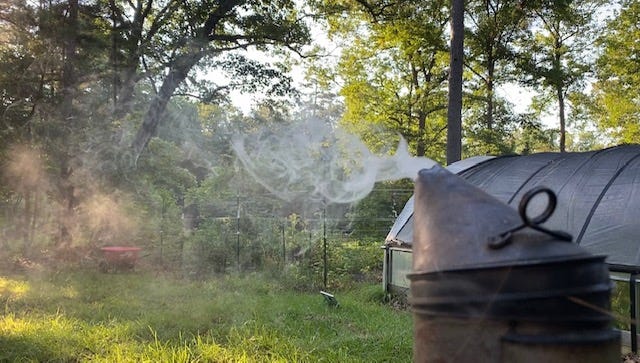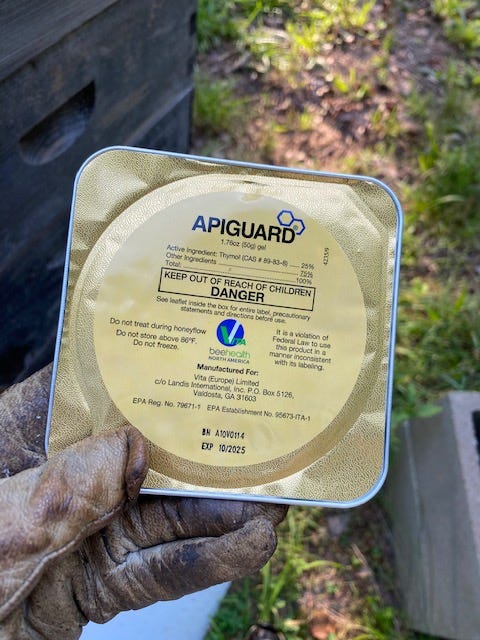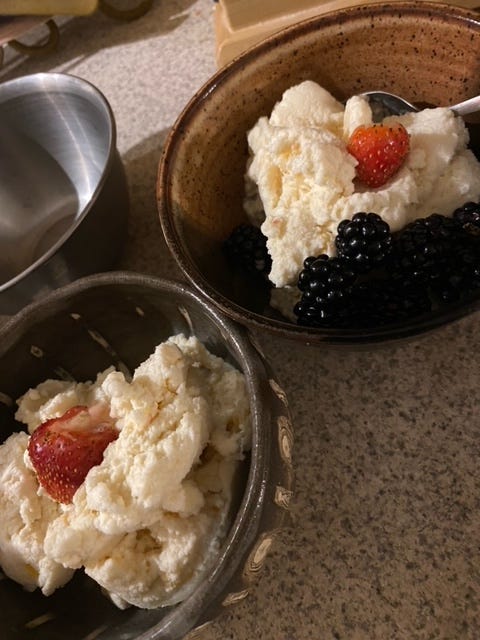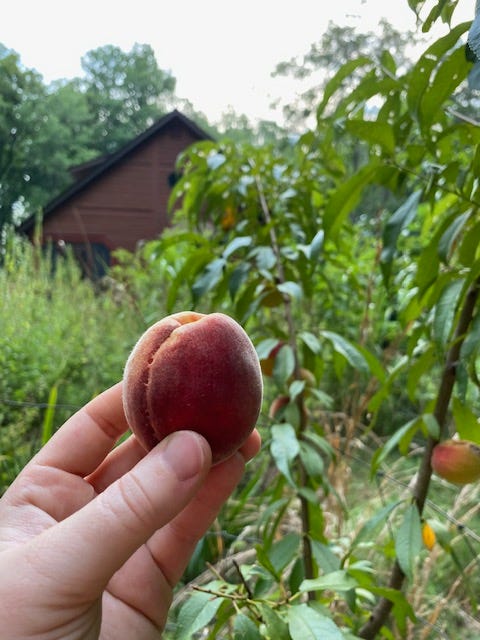Day in the life: Beekeeping in the summer in the South
Beekeeping looks different each season. Here’s a peek into life during the hottest and hardest season for the bees (and me).
Two quick notes: One, join me this Saturday, July 13 in Pinehurst, NC at the North Carolina Beekeeping Association’s Summer Conference. At 11 a.m. I present Permaculture Design in Apiaries and Pollinator Gardens. Two, I have a colony for sale. It’s a Pittsboro, NC spring queen who’s almost 2 months old laying beautiful brood. She’s available as a nuc, 10 frames, or 20 frames. I only run mediums. Pricing includes the bees and frames only—you supply the hive bodies, bottom board, and inner and top covers. Contact me for pricing.
Main goal of each season
Depending on where you are in the world, seasonal beekeeping goals look different. Keeping bees in North Carolina generally includes the goals of: winter survival, spring honey harvest, summer varroa control, and fall prep for winter. Minimizing moisture and drafts, and ensuring adequate food helps colonies survive winter. Providing enough space and managing swarms helps preserve the honey harvest. Having and implementing a plan for varroa control in the summer helps prevent colony loss. Robbing prevention and space management helps colonies build up in the fall and sets them up for to successfully survive winter.
Always have a goal for each hive inspection
Those larger seasonal goals are always on my mind when I’m checking hives, plus I have one goal for each hive inspection. It’s one of the first “rules” beekeepers learn. Often times the goal is to find the queen or see her eggs—signs that the colony isn’t missing a queen. Sometimes the goal is: Kill as many hive beetles as possible. The goal (usually) helps minimize inspection time so that the bees aren’t disrupted too much, plus it helps give each colony what they need.
Summer threats to honey bees
Today I’m sharing a peek into what it’s like to keep bees in the summer post-honey harvest. If I shared a peek into winter beekeeping, the big difference you would notice is that I would inspect during the warmest time of the day—either noon or mid-afternoon. Right now, it’s the opposite. The earlier the better in the summer heat. (My beekeeping mentor wears an ice vest when he inspects!)
While heat is a threat to me, the bees have to manage that and more. The summer dearth—a time when nectar-producing plants are hard to find—is in full swing. This makes other honey bee colonies and native pollinators hangry and determined, which can turn into a robbing frenzy. If hives lack a secured entrance, wasps, hornets, or area honey bees will target a weak colony and rob them of all of their honey.
Robber pests aren’t the only ones. All pests peak in the summer. Varroa mites breed on baby honey bees (brood) and queens are laying more right now to build their populations up for fall. All of the extra brood means more varroa mites. Small hive beetles (SHB) also take advantage of hives this time of year. SHB eat everything. Brood. Wax. Honey. It’s awful. Strong colonies can usually police and corral the beetles by sealing them in propolis “jails” until they die.
Why I avoid evening inspections
One thing you’ll notice from this timeline of a recent day inspecting hives is that it’s hot. Some beekeepers choose to inspect their hives in the evenings in the summer. I’ve done that before and I do it when necessary, but I avoid it if I can. Evenings are almost always hotter than the early morning hours. You have a clean slate with bees in the morning—they’ve had a full night of rest and that first light prompts them to focus on foraging, so they’re preoccupied. In the evening, they may have had a rough day—maybe they fought robber bees all day and they think I’m coming to do the same. They’re essentially done foraging for the day, so you have a greater number of bees in the hive, which can make it harder to work the frames. If I notice the hives need something like equipment, I have an opportunity with a morning inspection to get supplies during the day and give them what they need in the evening. With an evening inspection, that can delay getting them what they need. Aside from all of these reasons, my big one is that I’m a morning person. I’d much rather do mentally and physically exerting work first thing in the morning before the day’s inertia rolls out and potentially compromises things.
With all of that for context, here’s a recent day in my life juggling hive inspections in the summer while working full time:
6:00 a.m. – The time I hoped to get up.
6:09 a.m. – Sunrise.
6:45 a.m. – The time I actually get up. Check the chick brooder where I have 28 baby quail hopping around. Their brooder is in my beekeeping supply room, so I organize my gear and check my hive inspection notes from last time. I forgot to pick up/order mineral oil for small hive beetle traps, and I feel bad the bees need to go a few more days without beetle support. I add a note to the top of my shopping list to pick some up. Some of my notes suggest I may need to remove boxes from a few hives because they may not need the space (and less space is easier for them to manage beetles), so I make room in the hive equipment freezer in case I need to bring some boxes in. For the chicks, I add a fresh layer of straw to the brooder, clean their water, and top off their feed.
7:10 a.m. – Make a smoothie. My go-to smoothie is always banana, peanut butter, cacao, and blueberries, with a cashew milk base. I recently found a palm oil-free Nutella equivalent, Fine & Raw chocolate hazelnut spread, at Willabee Market in Southern Pines, NC (a lovely market run by a beekeeper mother-daughter team). Instead of my usual smoothie, I make a banana, blueberry, hazelnut spread, yogurt, and cashew milk smoothie. I lay back down in bed for a few minutes to brace myself for the summer heat and humidity. I realize I shouldn’t have had a banana smoothie before going to the hives—the banana aroma is similar to their alarm pheromone and may agitate them.
7:30 a.m. – Head back to the bee room to suit up. I don’t have a full beekeeping suit (I don’t care for them for several reasons that I can describe another time), instead I have loose pants, a top, veil, and an extra shirt, plus gloves, and I tuck my pants into my socks. I also tape down my veil with duct tape to prevent unexpected bees from crawling up under the veil.
7:40 a.m. – Light the smoker. I typically don’t need it, but since I’m worried about having the banana smoothie and I’m pressed for time this morning, I decide to light it to prevent having to stop mid-inspection and light it. Because of the humidity and recent rain, there’s no dry pine straw to use. I keep a box of dry pine straw in the outbuilding next to the hives, so I use that and it lights up right away.

7:45 a.m. – Start inspecting. I need to inspect all 8 hives—5 in my original apiary and 3 in a newer one. My goals with the hive inspections today are to check for brood or a queen, move their mite treatment, if necessary, and gauge if any hive needs more or less space. I’m treating all of the hives with Apiguard, a thymol-based varroa mite treatment approved for chemical-free beekeeping. The tray of Apiguard needs to rest above the brood nest. Sometimes the queen starts laying eggs in the box above the tray. If I see that, I move the tray further up in the hive. Fortunately, the bees are as calm as ever and my banana smoothie didn’t trigger their alarm pheromone. The humidity is awful and I feel like I’m moving in slow motion.

8:15 a.m. – I’m not even halfway done with inspections. I check my largest hives first. Between all of the hive boxes and the heat, I’m working slow. Two of the colonies that I expected to remove boxes from still look like they don’t need the extra space—however, they have a half dozen frames of capped brood, which means thousands of bees will emerge soon. Then they’ll definitely need that extra space. I decide to wait another week or two before removing any boxes. I’m sweating so much that my shirt sticks to my stomach. So much for wearing loose-fitting clothing!
8:30 a.m. – I finish inspecting the 5 larger hives and move over to the smaller, newer bee yard. This is one that has the small hive beetle issue. I only found a handful of beetles in the main yard, but this newer one isn’t in full sun all day, and it abuts a few pine trees—a favorite habitat for small hive beetles. All 3 of the hives have an uncomfortable number of beetles in them and I promise to add traps before the end of the week. I kill as many beetles as I can. The strongest colony hasn’t worked a new box that I gave them almost a month ago. It has a few dozen beetles roaming the fresh frames, so I remove that box and place it in the freezer. I realize I have half of my swarm trap sitting by the back door and that needs to go in the freezer too. I had taken down my swarm trap because I needed the equipment for a small swarm I caught next to one of my hives the day after I extracted honey. The heat has made me sweat through my shirt so much that it’s made the duct tape detach from my veil. Fortunately, all of the hives were completely calm and those gaps to my veil didn’t matter.
8:45 a.m. – I put my gear away, peel off my beekeeping clothes, and immediately throw them in the washing machine. I’m grateful for prioritizing frequent visits to the sauna over the winter to prepare me for this summer heat.
8:50 a.m. – Shower heaven.
9:05 a.m. – Log on to work. Fortunately, no Zoom time until 10, so I’m not late to a meeting.
12 p.m. – Visit the chicken coop to see what the girls have laid for my lunch. Pull a plate from the fridge of bacon from our pigs that I thawed the night before. While having lunch I check my beekeeping email. A friend and designer sent me quotes for a beekeeping t-shirt design and a book cover design. I’m hoping to offer shirts next year. I play tug of war with our dog, Indy, inside since it’s too hot to take him for a walk, and refresh the chick brooder with clean water and feed.
1:00 p.m. – Back to work.
4:30 p.m. – I turn off the computer and it’s time for Indy’s “chores.” He comes with me to the quail coop, garden, chicken coop, and then we clean the chick brooder and set them up with fresh bedding. It’s still too hot to take him for a walk, so this is a fun time for him to run a little between his chores.
5:15 p.m. – I notice one of the peach trees has some ripe fruit. I pick some and decide to make a peach frozen yogurt for dessert.
5:20 p.m. – Just as sweaty as the morning. Time for shower #2.
5:45 p.m. – Feed Indy and take out ingredients for dinner. I’m making an enchilada skillet bake—a recipe from the original Inspiralized cookbook that I haven’t made in ages. Instead of rice it uses spiralized carrots (I use sweet potatoes) that you pulse in the food processor to turn into “rice.” It’s made of so many veggies, takes a short time to bring everything together in the skillet, and then it bakes for a while. It’s very filling, plus it makes only one skillet to clean up and I’m all for that.
6:30 p.m. – Dinner time.
7:00 p.m. – Clean up the kitchen and set up the ice cream maker for the frozen yogurt.
7:30 p.m. – Enjoy the peach froyo while watching YouTube. A few of the many beekeeping channels I follow: National Honey Show and Bob Binnie of Blue Ridge Bees.

8:00 p.m. – Even thought it’s still hot, I want to take advantage of the somewhat less blazing evening to go for a walk with Indy. We walk a mile.
8:30 p.m. – Sweaty again. Time for shower #3. This is the time of year I call the Season of Many Outfits, and a friend calls it the Season of Many Showers. Both are fitting!
8:37 p.m. – Sunset.
9:00 p.m. – Chill with Indy and my husband watching random YouTube videos.
9:45 p.m. – Refresh the quail brooder for the night. Another layer of fresh bedding, clean water, and more feed.
10:00 p.m. – Reading before bed includes Raising Resilient Bees.
10:30 p.m. – Sleepy time.
Let me know if you have any questions about beekeeping in the summer.




